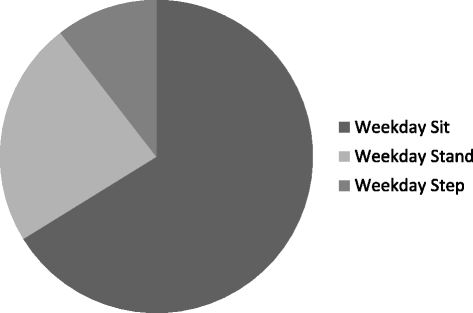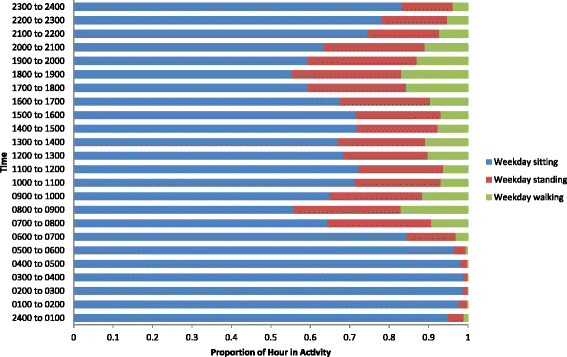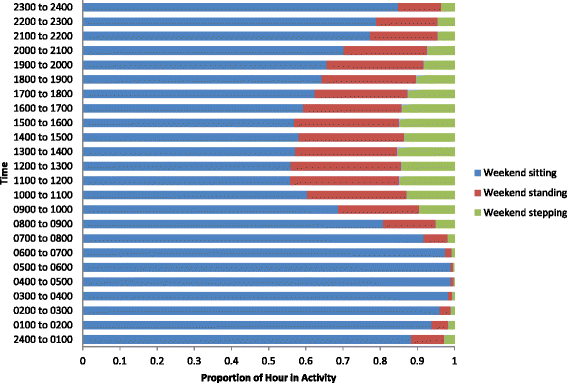Weekday and weekend patterns of objectively measured sitting, standing, and stepping in a sample of office-based workers: the active buildings study
- PMID: 25595219
- PMCID: PMC4308830
- DOI: 10.1186/s12889-014-1338-1
Weekday and weekend patterns of objectively measured sitting, standing, and stepping in a sample of office-based workers: the active buildings study
Abstract
Background: There is a growing body of research into the total amount and patterns of sitting, standing and stepping in office-based workers and few studies using objectively measured sitting and standing. Understanding these patterns may identify daily times opportune for interventions to displace sitting with activity.
Methods: A sample of office-based workers (n = 164) residing in England were fitted with thigh-worn ActivPal accelerometers and devices were worn 24 hours a day for five consecutive days, always including Saturday and Sunday and during bathing and sleeping. Daily amounts and patterns of time spent sitting, standing, stepping and step counts and frequency of sit/stand transitions, recorded by the ActivPal accelerometer, were reported.
Results: Total sitting/standing time was similar on weekdays (10.6/4.1 hrs) and weekends (10.6/4.3 hrs). Total step count was also similar over weekdays (9682 ± 3872) and weekends (9518 ± 4615). The highest physical activity levels during weekdays were accrued at 0700 to 0900, 1200 to 1400, and 1700 to 1900; and during the weekend at 1000 to 1700. During the weekday the greatest amount of sitting was accrued at 0900 to 1200, 1400 to 1700, and 2000 to 2300, and on the weekend between 1800 and 2300. During the weekday the greatest amount of standing was accrued between 0700 and 1000 and 1700 and 2100, and on the weekend between 1000 and 1800. On the weekday the highest number of sit/stand transitions occurred between 0800 to 0900 and remained consistently high until 1800. On the weekend, the highest number occurred between 1000 to 1400 and 1900 to 2000.
Conclusion: Office based-workers demonstrate high levels of sitting during both the working week and weekend. Interventions that target the working day and the evenings (weekday and weekend) to displace sitting with activity may offer most promise for reducing population levels of sedentary behaviour and increasing physical activity levels, in office-based workers residing in England.
Figures







References
-
- Colley RC, Garriguet D, Janssen I, Craig CL, Clark J, Tremblay MS. Physical activity of Canadian adults: accelerometer results from 2007 to 2009 Canadian Health Measures survey. Health Rep. 2011;22:15–22. - PubMed
Publication types
MeSH terms
Grants and funding
LinkOut - more resources
Full Text Sources
Other Literature Sources
Medical

